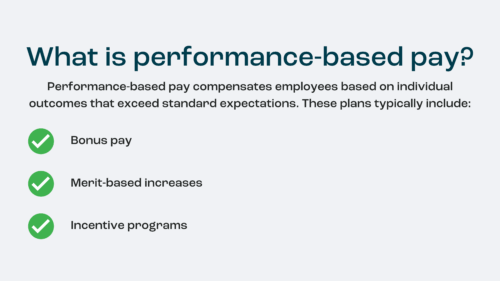
Performance-based pay can be a powerful motivator—but only if aligned with clear expectations, consistent feedback, and a well-structured compensation plan. Let’s explore the benefits and risks, along with best practices, to help you decide if this pay model fits your workforce strategy.
What Is Performance-Based Pay?
Performance-based pay compensates employees based on individual performance or outcomes that exceed standard expectations. These plans typically include:
- Bonus pay (cash, stock, or variable pay)
- Merit-based pay increases
- Short-term and long-term incentive programs
A well-designed compensation plan sets clear performance metrics, defines eligibility, and ties rewards directly to business impact.

Pros of Performance-Based Compensation
Motivates Employees to Perform
Aligning employee earnings with performance results can encourage employees to work harder, think more strategically, and take ownership of their goals. Rewards linked to good performance give employees a clear reason to strive, putting them in the driver’s seat of their career and financial growth.
Improves Visibility into Performance Gaps
Performance-based pay helps leaders identify high-performing individuals and teams while exposing where support may be lacking. This data becomes the foundation for targeted development efforts, performance improvement plans, and team-based coaching.
Enhances Retention of Top Talent
Rewarding your best contributors with additional compensation makes them feel seen and reduces their likelihood of leaving. Performance-based compensation helps you stay competitive with outside offers by showing employees you recognize their impact through pay.
Helps Build Better Recruiting Pipelines
Analyzing attributes of top earners can refine hiring profiles and help recruiters better align new hires with performance expectations. This approach leads to stronger, faster team alignment and a lower turnover risk.
Cons of Performance-Based Pay
Risk of Misaligned Expectations
Without clear performance expectations, employees may misunderstand how to earn additional compensation. Employees can feel frustration, mistrust, or resentment, especially if compensation seems subjective or unevenly distributed.
However, a well-structured and transparent performance-based pay system can mitigate these risks, ensuring fairness and confidence in the process.
May Shift Focus Away from Long-Term Goals
If too much focus is placed on short-term bonuses, employees may neglect broader company initiatives, collaboration, or development. However, a performance-based model that carefully balances short-term incentives with long-term growth strategies can ensure that employees remain focused on immediate goals and the company’s long-term vision, providing a strategic alignment that reassures the audience.
Potential to Hurt Profit Margins
Incentive-based pay plans can be counterproductive if the rewards are not properly adjusted. Without safeguards, you might offer generous bonuses that don’t correlate with measurable return on investment (ROI). The model may reduce profits if team-based bonuses are not aligned with wider performance metrics.
Types of Performance-Based Compensation
Merit-Based Pay Increases
Merit-based raises increase your employees’ base salaries as a reward for consistent, measurable performance. These are typically awarded annually based on formal performance appraisals or goal attainment. This type of performance-based compensation encourages long-term development by reinforcing strong habits and results over time. It’s also popular because it provides predictable, ongoing rewards tied directly to individual performance.
Example:
A 3% merit increase for a team member earning $50,000 raises their salary to $51,500. If that team member consistently exceeds expectations, they might also be eligible for a 5% increase the following year, creating long-term earning potential and financial stability.
Variable Pay (Short-Term Incentives)
Quarterly or semi-annual bonus programs are often tied to individual, team, or company performance. These include discretionary bonuses (like spot or project bonuses) and non-discretionary bonuses (based on set goals). Unlike merit increases, variable pay rewards short-term accomplishments and offers flexible payouts aligned with current business needs or campaign outcomes.
This performance-based compensation keeps employees engaged throughout the year, creating opportunities to reward standout contributions in real time.
Team- and Company-Wide Incentives
Some organizations use team-based incentive models to reward cross-functional collaboration or entire departments when employees hit certain KPIs.
Best Practices for Implementing Performance-Based Pay
Employers must support performance-based pay with strong processes for evaluating individual performance fairly and consistently. Here’s how:
1. Prepare Ahead of Time
Before offering merit-based pay, review each employee’s progress over time:
- Pull performance metrics, goal completions, and feedback.
- Involve peers or cross-functional partners when relevant.
- Revisit past reviews and compensation plans for continuity.
This foundation shows employees that decisions about their earnings are thoughtful and backed by real data.
2. Use Clear, Measurable Criteria
Every performance-based compensation model needs well-defined criteria. Tie rewards to specific outcomes—like project completions, sales numbers, or quality metrics—and align those with the employee’s job description.
Use a standardized review scale and document what satisfactory performance looks like in each role. This clarity helps employees understand what’s required to earn additional compensation and reduces bias.
3. Make Reviews a Two-Way Conversation
Performance reviews should also be a space for reflection, goal-setting, and collaboration if tied to pay decisions.
Ask:
- “What accomplishments are you most proud of?”
- “Where would you like to grow next?”
- “What support do you need to succeed?”
Recognize hidden contributions, such as leadership in ERGs or mentoring, which may not show up in raw performance metrics but reflect long-term employee value.
4. Set Actionable Goals
Follow up reviews with a clear action plan. Goals should be SMART (Specific, Measurable, Achievable, Relevant, and Time-Bound) and ideally tied back to team—or company-level KPIs. For instance, a SMART goal could be to increase sales by 10% in the next quarter, which is specific, measurable, achievable, relevant, and time-bound.
Motivation increases, and results follow when employees know how to earn bonuses or promotions.
5. Design a Compensation Plan That Balances Performance and Culture
Recruiting and retaining talent becomes easier when candidates understand how they’ll be evaluated and rewarded. A modern compensation plan should combine a competitive base salary with flexible incentives tailored to role type and contribution.
This approach allows companies to recognize individual performance while encouraging team-based collaboration. High-performing employees want to know their efforts are valued and rewarded fairly, but so do steady, reliable contributors.
Not every employee is in a revenue-driving role, and that’s where a mix of merit-based pay and cultural recognition (like Employee Resource Group (ERG) involvement or mentorship roles) adds balance.
Cultural recognition refers to acknowledging and rewarding employees for their contributions to the company’s culture and values, which may not directly impact revenue but are still important. The goal is to create a compensation ecosystem that motivates employees without adding undue pressure.
6. Keep Feedback Continuous
Employees shouldn’t be left guessing how they’re doing. Supplement annual reviews with monthly or quarterly check-ins to track progress and reinforce performance expectations.
This ongoing communication loop builds trust, gives managers early insight into blockers, and makes end-of-year pay decisions easier and more transparent.
A well-structured performance review process can reveal more than just performance gaps—it can also identify ways to enhance employee engagement through targeted incentives. Employees who receive regular feedback are more likely to align their efforts with performance expectations.
Real-World Examples
📈 Merit-Based Increase
- Example: An employee with a $60,000 salary receives a 4% raise after meeting all quarterly goals, increasing their salary to $62,400.
🎁 Discretionary Bonuses
- Project bonus: An employee who completes a key software rollout ahead of schedule and under budget earns a one-time $1,500 bonus.
📊 Non-Discretionary Bonus
- Team bonus: A department exceeds its Q3 revenue target by 15%, triggering a $750 bonus per team member.
Is Performance-Based Pay Right for You?
When designed well, performance-based compensation can help you motivate employees, retain top talent, and align pay with results. But it’s not one-size-fits-all.
Ask yourself:
- Are your performance metrics clearly defined?
- Do your managers know how to run consistent, fair reviews?
- Is it clear how employees receive additional compensation?
If the answer is “not yet,” you may want to pair incentive pay with tools that help track performance, deliver real-time feedback, and build meaningful long-term development paths.
How APS Can Help
APS offers a modern HR and performance management platform that makes it easy to manage merit-based pay, bonuses, and employee goals—all in one place. From tracking KPIs to scheduling performance reviews, our tools give you the clarity and structure to reward employees with confidence.
Ready to make your performance reviews more organized, consistent, and connected to your compensation strategy?
Get in touch with an HCM expert today.
Sources
- Designing and Managing Incentive Compensation Programs | SHRM
- Advantages and Disadvantages of Merit Pay | The Balance
- Performance-Based Compensation: What It Is And How To Approach It | People Managing People
- The Relationship between Performance and Compensation: Does Better Performance Follow the Money? | HR Professionals Magazine
- Pay for Performance | AIHR












